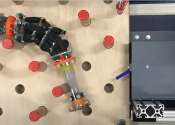Robotic thread is designed to slip through the brain's blood vessels
MIT engineers have developed a magnetically steerable, thread-like robot that can actively glide through narrow, winding pathways, such as the labrynthine vasculature of the brain.
Aug 28, 2019
0
969









